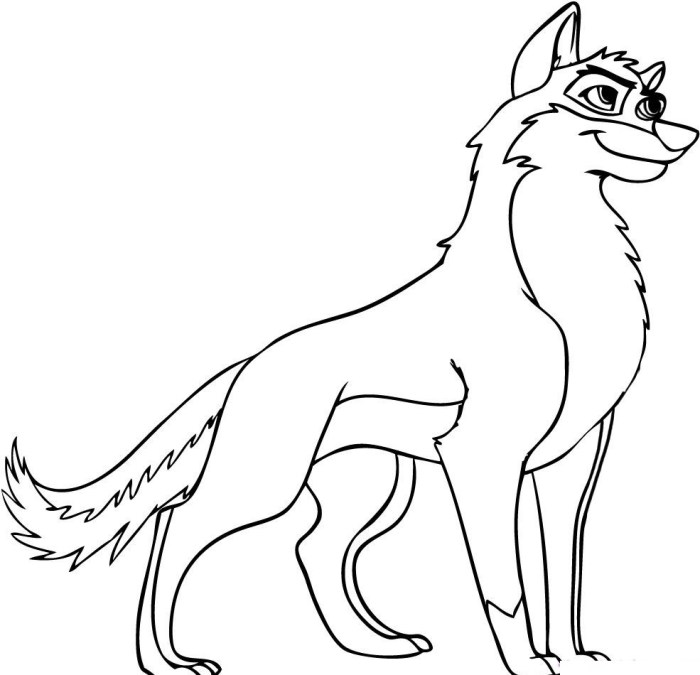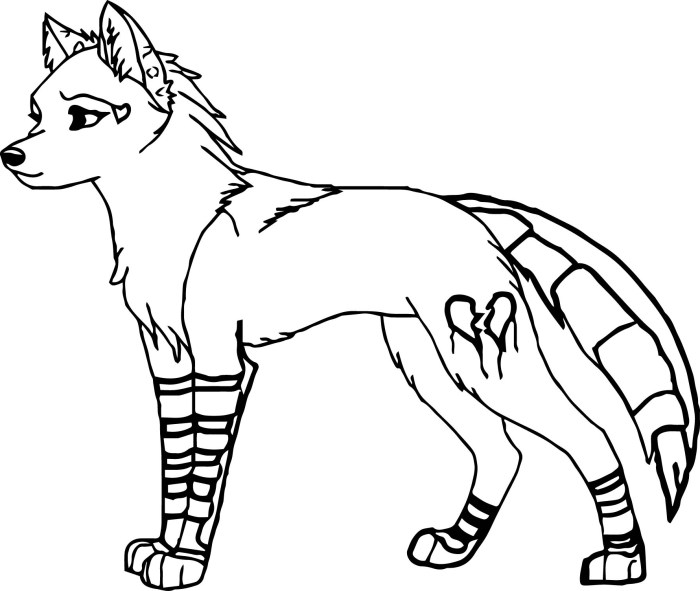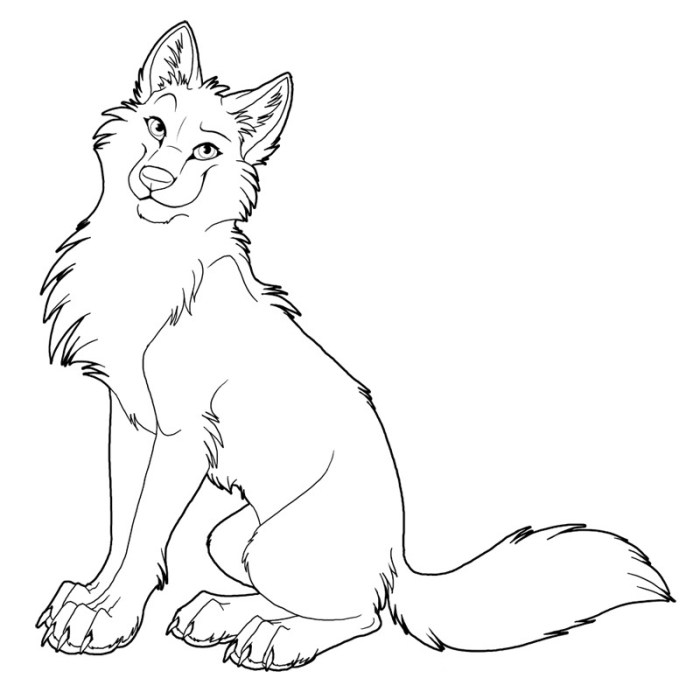Design Elements: Animated Wolves Coloring Pages

Animated wolves coloring pages – Popular animated wolf coloring pages often incorporate a range of design elements to appeal to a broad audience, balancing visual appeal with ease of coloring. These elements contribute to the overall aesthetic and the coloring experience itself. Successful designs consider both the artistic style and the practical aspects of coloring for children and adults.Design elements frequently found in these pages include simplified shapes for easy outlining and coloring, large areas for color application, and clear linework to prevent confusion.
The inclusion of engaging details, such as expressive eyes or textured fur, adds visual interest without overwhelming the design. Furthermore, the choice of artistic style and color palette plays a crucial role in establishing the overall mood and feel of the page.
Animated wolf coloring pages offer a fantastic way for children to explore their creativity, depicting these majestic creatures in various playful poses. For a similar creative experience featuring a different feline friend, check out the delightful selection of animated wildcat coloring pages. Returning to wolves, the expressive eyes and detailed fur in many of these coloring pages provide opportunities for intricate coloring and shading techniques, leading to truly captivating finished artwork.
Artistic Styles
The artistic style significantly impacts the overall look and feel of the wolf coloring page. A variety of styles cater to different preferences and skill levels.
- Cartoon Style: This style utilizes exaggerated features, simplified shapes, and bold Artikels. Wolves often have large, expressive eyes, short snouts, and rounded bodies. Think of the playful, friendly wolves often seen in children’s animation. Colors are typically bright and vibrant.
- Realistic Style: This style prioritizes anatomical accuracy and detailed fur rendering. Wolves are depicted with lifelike proportions, musculature, and textures. The linework is often more intricate, requiring a higher level of coloring skill. Color palettes tend to be more muted and natural.
- Semi-Realistic Style: This style blends aspects of both cartoon and realistic styles. Wolves retain some realistic features, such as accurate anatomy, but with simplified details and slightly exaggerated features. This approach offers a balance between visual appeal and coloring accessibility.
Color Palettes
The selection of colors significantly impacts the mood and overall aesthetic of the coloring page. Different color palettes evoke distinct feelings and suit various artistic styles.Common color palettes include:
- Warm Palettes: Utilizing shades of red, orange, yellow, and brown, these palettes create a feeling of warmth, energy, and happiness. They are frequently used in cartoon-style wolf coloring pages, emphasizing a friendly and playful atmosphere.
- Cool Palettes: Employing blues, greens, purples, and grays, these palettes can evoke a sense of calmness, mystery, or even sadness. They are often suited to more realistic or semi-realistic styles, allowing for a more subdued and atmospheric portrayal of the wolf.
- Monochromatic Palettes: Using variations of a single color, these palettes create a unified and harmonious look. They can range from light to dark shades of a single color, offering opportunities for shading and depth. This can be effective in both cartoon and realistic styles.
Animated Wolf Coloring Page Concepts
Below are three unique concepts for animated wolf coloring pages, each with a distinct artistic style and color palette.
- Concept 1: Playful Pup: A cartoon-style wolf puppy, with oversized paws and expressive eyes, playing in a field of wildflowers. The style is simple, with large, clearly defined areas for coloring. The color palette is bright and cheerful, featuring vibrant pinks, yellows, blues, and greens.
- Concept 2: Majestic Alpha: A semi-realistic wolf, depicted in a powerful pose against a dramatic mountain backdrop. The style incorporates detailed fur textures and musculature, but with simplified features for easier coloring. The color palette is more muted, using earth tones with hints of cool blues and grays.
- Concept 3: Mystical Moonlit Howl: A stylized wolf howling at a full moon, with flowing lines and ethereal details. The style is slightly abstract, emphasizing movement and emotion. The color palette is predominantly cool, with deep blues, purples, and silvery grays, creating a mystical atmosphere.
Target Audience and User Experience

These wolf coloring pages are designed to be engaging and enjoyable for a broad range of users, primarily focusing on children and young adults. Understanding their preferences and needs is crucial for creating a positive and enriching experience. A successful design considers factors such as age-appropriateness, visual appeal, and ease of use.The primary target audience for these coloring pages consists of children aged 4 to 12 years old, with a secondary audience encompassing teenagers and adults who enjoy creative activities and appreciate wildlife-themed artwork.
Their interests include animals, particularly wolves, fantasy, and creative expression. The design should cater to this range, providing complexity suitable for different age groups and skill levels.
Target Audience Demographics and Interests
The design of these coloring pages directly addresses the interests of the target audience. The inclusion of wolves, often depicted in captivating poses or within imaginative scenes, appeals to the fascination children and young adults have with these animals. The detailed line art offers a challenge for older children, while simpler designs cater to younger users. The absence of overly complex or potentially frightening imagery ensures appropriateness for all age groups within the target range.
Furthermore, the design avoids gender-specific stereotypes, aiming for broad appeal.
Factors Contributing to a Positive User Experience
Several factors contribute to a positive user experience. High-quality printable designs with clear lines and ample space for coloring are paramount. The pages should be easily downloadable and printable, requiring minimal technical expertise. The designs should be visually appealing, utilizing engaging color palettes and interesting compositions. Furthermore, a variety of wolf designs—some simple, some more intricate— caters to different skill levels and preferences, enhancing user satisfaction.
The use of high-resolution images ensures that the printed coloring pages are sharp and clear.
Effective Design Choices Enhancing User Engagement, Animated wolves coloring pages
Effective design choices significantly impact user engagement. For instance, incorporating different wolf breeds, poses, and expressions within the designs provides variety and visual interest. Including elements such as backgrounds, simple patterns, or accompanying text (e.g., names of wolf breeds) can enhance the overall experience. The use of bold, easily-visible lines prevents frustration and ensures children of different ages can easily trace the Artikels.
A visually appealing layout, with ample white space between designs, avoids a cluttered feel. Lastly, offering a variety of coloring page formats (single-wolf designs, multiple-wolf scenes, etc.) allows users to choose based on their preference and coloring experience.
Suggestions for Improving User Experience
While the current designs are strong, several improvements could further enhance the user experience. User testing with the target audience would provide valuable feedback on design preferences and identify potential areas for improvement. This could include assessing the complexity of designs and ensuring sufficient white space around the drawings. Introducing interactive elements, such as adding a simple online coloring tool or suggesting complementary activities, could further boost engagement.
Finally, offering a range of downloadable formats (e.g., PDF, JPG) increases accessibility and caters to various printing preferences.
Technical Aspects and Formats

Choosing the right file format for distributing animated wolf coloring pages is crucial for ensuring optimal viewing, printing, and file size management. Different formats offer varying advantages and disadvantages, impacting both the user experience and the technical feasibility of the project. Careful consideration of these factors will lead to a more successful product.Suitable file formats for animated wolf coloring pages include PDF, JPG, PNG, and GIF.
Each offers a unique balance of quality, file size, and ease of use. The optimal choice depends heavily on the intended use (online viewing versus printing) and the technical capabilities of the target audience.
File Format Comparison
The following table compares the suitability of different file formats for animated wolf coloring pages, considering file size, print quality, and ease of use.
| Format | Pros | Cons | Best Use Case |
|---|---|---|---|
| Preserves vector graphics and text quality; good for printing; supports animation (with limitations); widely compatible. | Larger file sizes compared to raster formats; animation support can be limited depending on the software used to create it; may require specific software to open. | High-quality printing and distribution where animation is a secondary feature; situations where preserving text and vector elements is important. | |
| JPG | Smaller file sizes; widely compatible; suitable for web use. | Loses image quality with compression; not ideal for line art; not suitable for animation. | Online distribution where file size is a primary concern and animation is not needed. Suitable for static images of colored wolf pages. |
| PNG | Supports lossless compression; maintains image quality; suitable for line art; transparency support. | Larger file sizes than JPG; not ideal for photographs; animation support limited, often resulting in larger file sizes. | Online distribution where image quality is paramount and transparency is needed (e.g., for layering colored elements); suitable for static images of wolf coloring pages. |
| GIF | Supports simple animation; small file size for simple animations; widely compatible. | Limited color palette (256 colors); animation quality can be low; not ideal for complex images or high-resolution animation. | Simple, short animations for online use, where file size and compatibility are crucial, but high quality isn’t paramount. |
Image Optimization for Online Use and Printing
Optimizing images for both online use and printing involves different strategies. For online use, the goal is to minimize file size without significant quality loss to ensure faster loading times. For printing, the goal is to maintain high resolution and color accuracy.For online use, consider using lossy compression techniques (like JPG) for photographs and lossless compression (like PNG) for line art.
Reducing image dimensions to the appropriate size for the web is also crucial. Tools like TinyPNG or ImageOptim can help compress images without noticeable quality loss.For printing, ensure images are at a high resolution (at least 300 DPI) to prevent pixelation. Use a color profile suitable for your printing method (e.g., CMYK for professional printing). Avoid over-sharpening, which can lead to artifacts.
Using tools such as Adobe Photoshop or GIMP allows for detailed control over image resolution and color profiles for print optimization.
